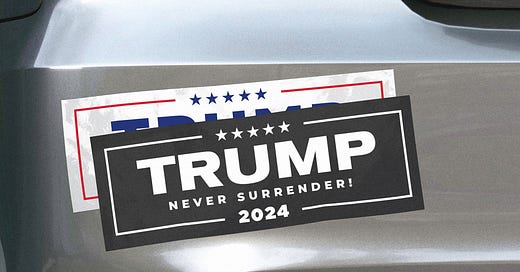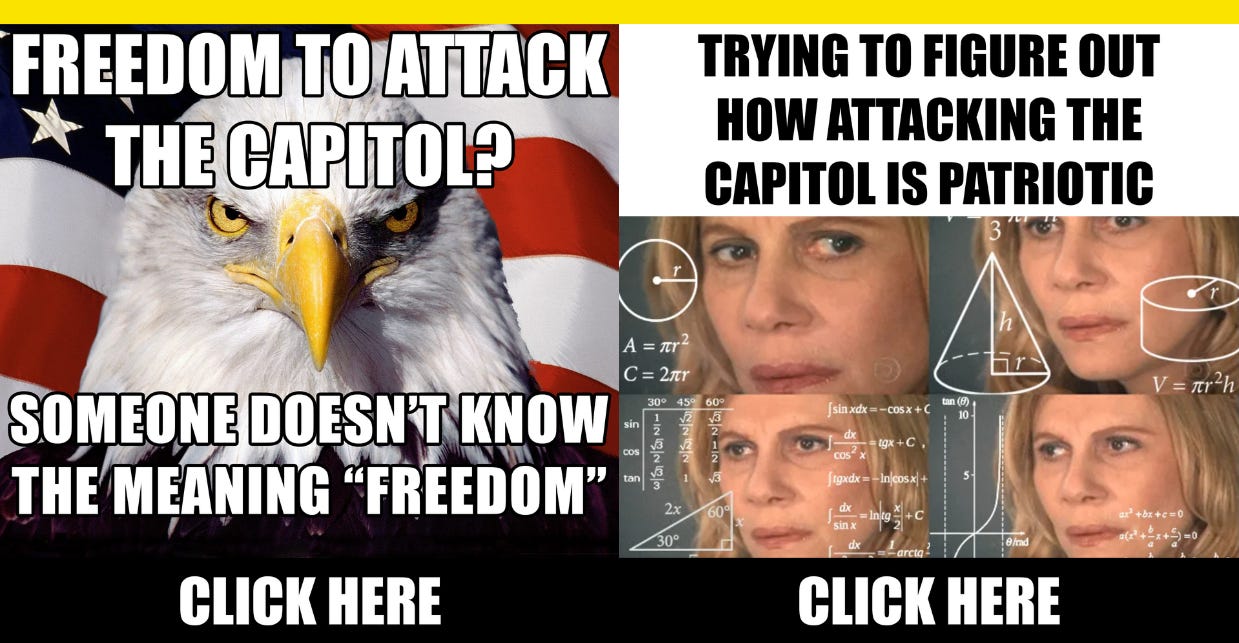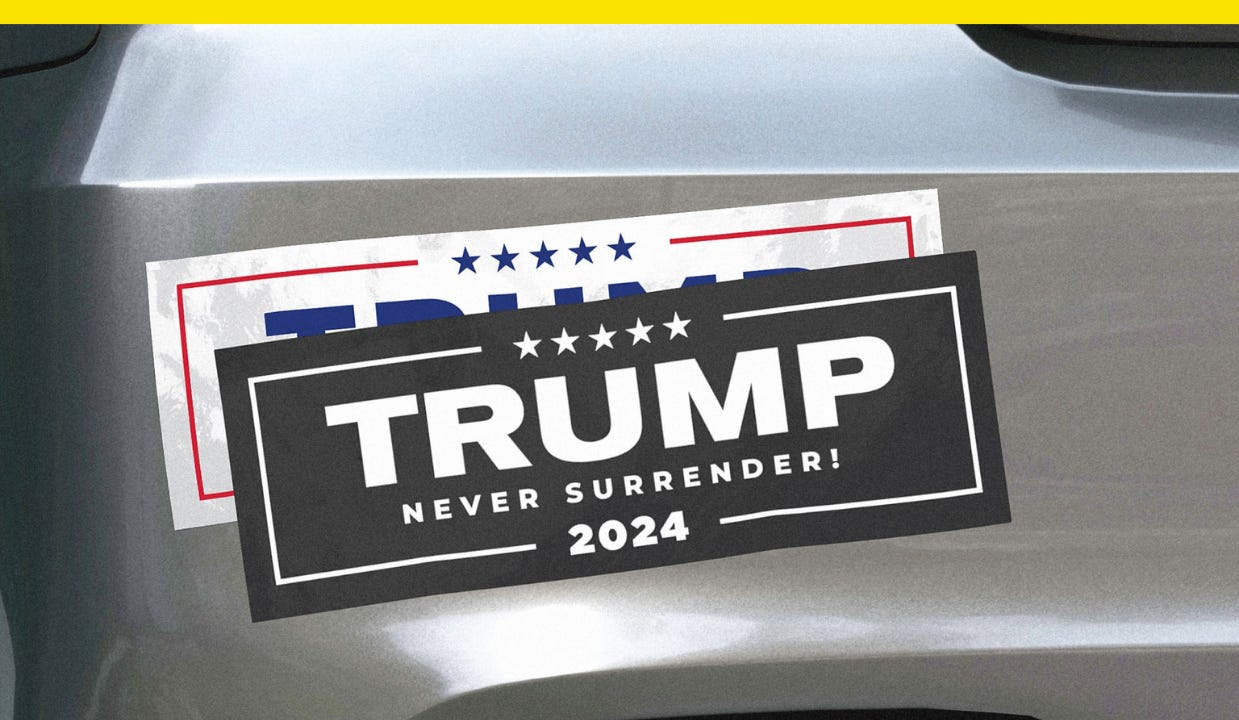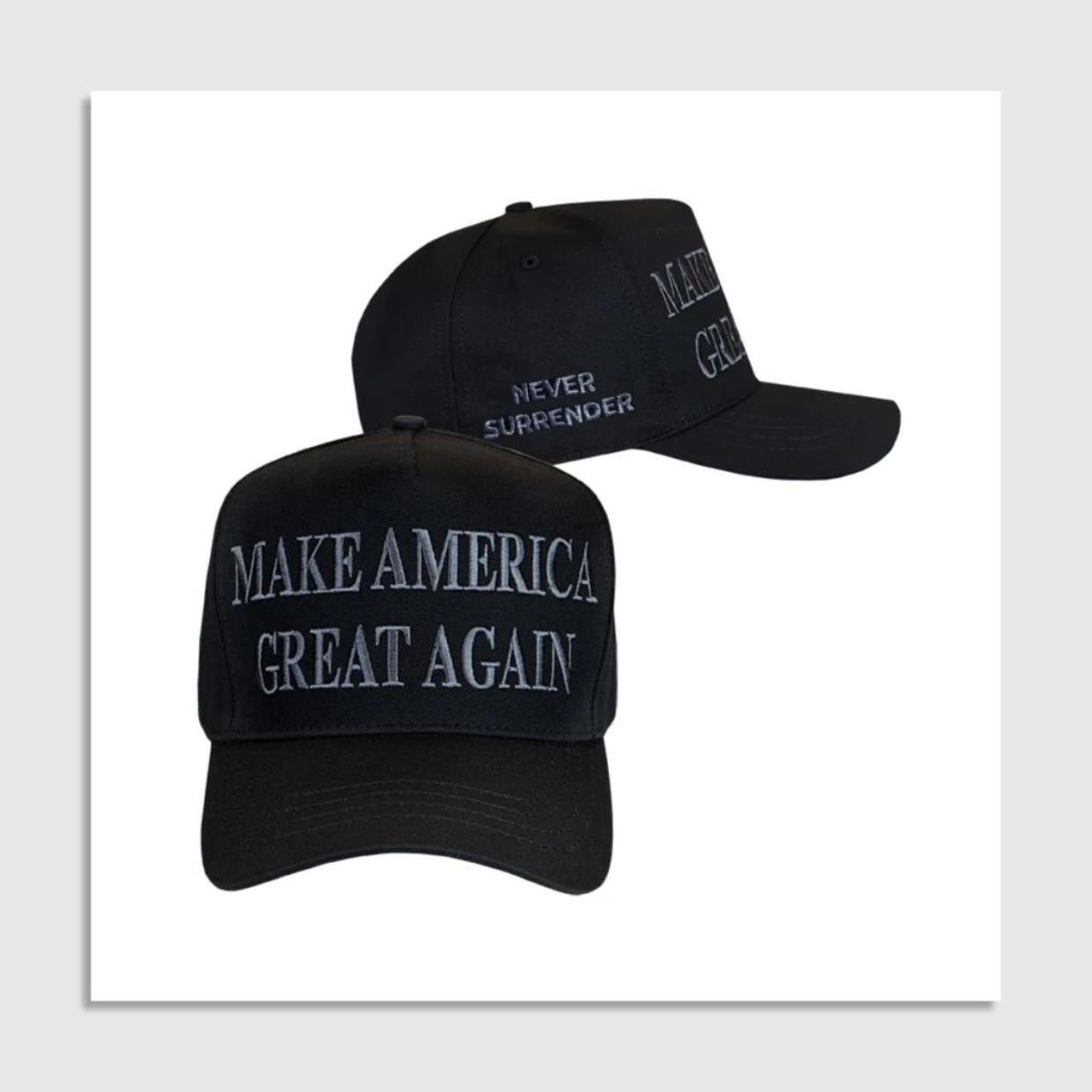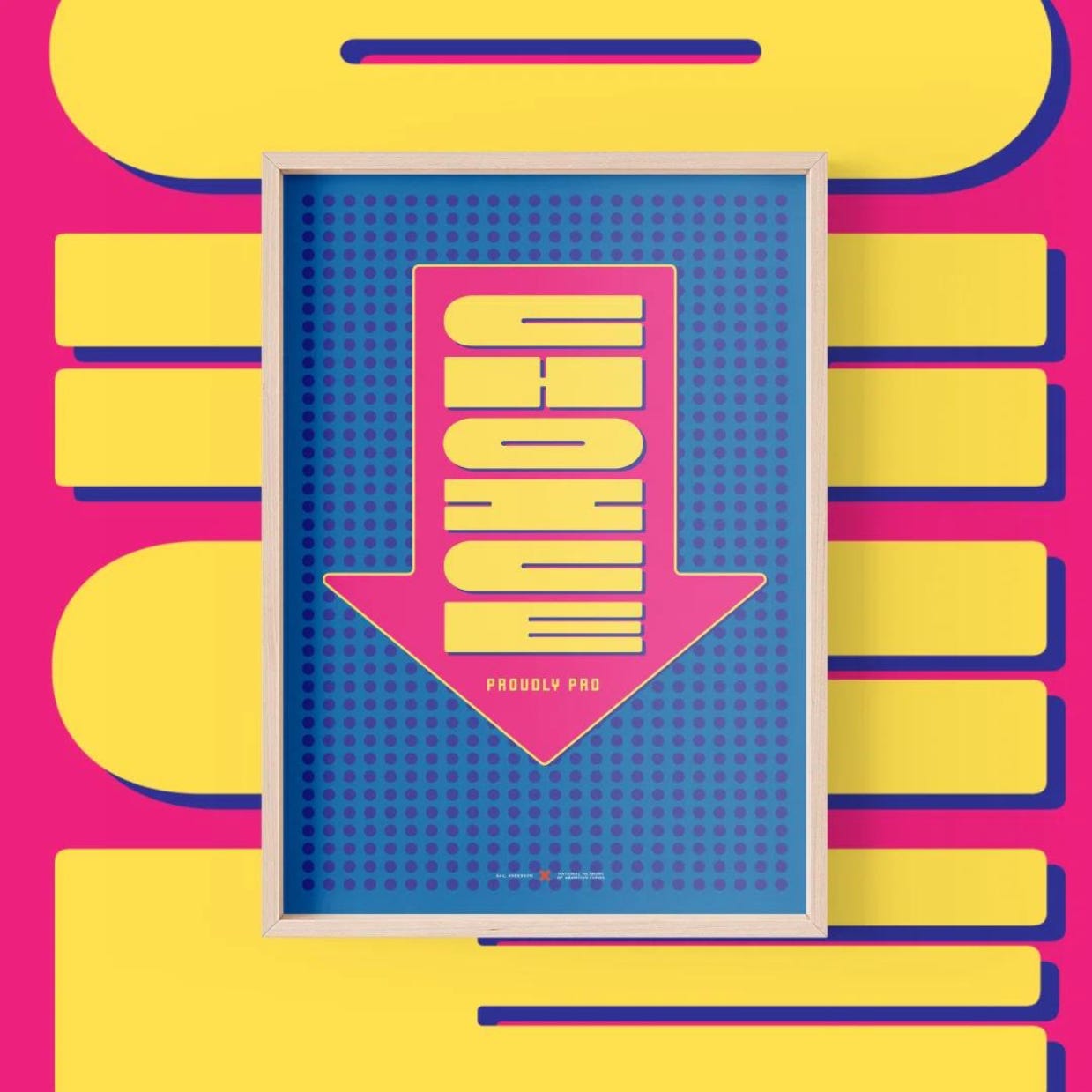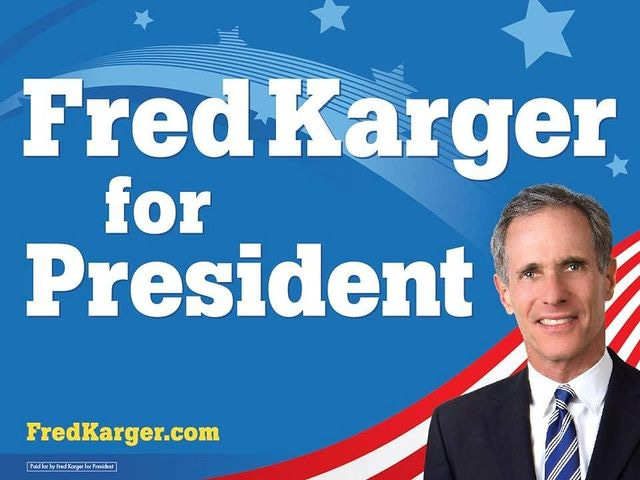Hello, in this issue we’ll look at…
Can memes beat back disinformation?
Trump just dropped a new campaign logo
Trump kissed a man. Now it’s in an attack ad.
Scroll to the end to see: how Meta classifies “memes” 📱
Can memes beat back disinformation?
In journalist Sasha Issenberg’s excellent The Lie Detectives, a book about how political campaigns are responding to disinformation, a group called We Defend Truth took a relatively novel approach to political persuasion: worry about engagement first and persuasion later.
The group ran ads that weren’t produced by traditional political admakers but by memesmiths. Beau Elliot, a gifmaker who posted on Reddit under the handle IH8MyPP, once made a gif called “Guardians of the Front Page” that used footage from “Guardians of the Galaxy” to poke fun at people who repost previously posted content on Reddit. It has more than 23 million views, and We Defend Truth co-founder David Goldstein reached out to see if Elliot be open to doing political work. As long as it wasn’t for Trump, Elliot said.
The Lie Detectives details how Elliot made memes during the 2020 campaign for a partisan group called TruthNotLies that was a forerunner to We Defend Truth and started by some of the same co-founders. His memes hit Trump for paying off a porn star to keep their alleged affair quiet by using a scene from The 40-Year-Old Virgin, and another meme used characters from The Office perplexed by Trump saying “I wish her well” regarding Ghislaine Maxwell after she was arrested in the Jeffrey Epstein sex-trafficking case. The ads, which ran in Pennsylvania, were estimated to have generated 20,000 net Democratic votes.
After the 2020 election, Elliott made memes for We Defend Truth intended to sway voters who falsely believed the election was stolen by creating content more compelling that your average stuffy fact check.
“Conspiracy theories are immensely entertaining and fascinating and have a snack-like quality that you just want more and more of it,” Issenberg tells me. “We have to accept that they’re entertaining.”
In contrast, fact checks have a “do your homework,” or “eat-your-vegetables quality,” he says. “Read this boring thing that tells you why the fun thing isn’t true, and that’s noble, I don’t want to discount that, but that doesn’t seem to really understand how the internet, and especially social media, work.”
Eyeballs first, hearts and minds second
We Defend Truth divided Republican voters who believed the 2020 election was stolen into three subsets: “Strong Big Lie Believers” who believed President Joe Biden didn’t actually win the election, “Big Lie Believers,” who had doubts about the election results, and “Believers by Default,” who were unsure about stolen election claims or believed or rejected them weakly.
We Defend Truth tried five different creative tracks for the memes, like “Harmony,” which called for moving past the division of 2020 and “Demystify Voting,” about showing how large-scale voter fraud is virtually impossible. Some memes actually backfired with their intended audiences, like one comparing the U.S. to a North African dictatorship using a speech from Sacha Baron Cohen’s The Dictator under the “Rule of Law” creative track. The “What America Does Best” track, which played to viewers’ sense of patriotism in American democracy, moved the needle for Republicans opposed to Trump but not “Believers by Default.”
Still, when the ads ran in Georgia, Pennsylvania, and Nevada targeted at “Entrepreneurial Conservatives,” 98% of user interactions with the content was positive, like likes, loves, and shares. Paid advertising usually doesn’t get that much love (there’s a reason Meta is testing unskippable ads), and that’s especially true for political ads. Goldstein, the We Defend Truth co-founder, included the user interaction statistics in a summary sent to donors because, as he says in the book, “most advertising campaigns — corporate or political advocacy of any type — don’t really anticipate that the target audience will enjoy their advertising.”
For 2024, Goldstein says he’s planning on an anti-disinformation campaign on autocracy and working with people like Dr. Karen Stenner, an Australian political psychologist who researches authoritarianism, and the culture-jamming group the Yes Men, which he’s building a library of digital content with.
“If you want to engage people and if you want to talk to them, you worry about eyeballs first, hearts and minds second, and there really is no other approach,” he tells me.
Trump just dropped a new campaign logo
Former President Donald Trump’s campaign has a new logo.
And while the overall design of this new secondary logo will look familiar to those who have seen the previous iteration, it also has a few visual differences that point to his campaign’s current messaging strategy.
There are three changes. This version of the logo swaps out its red, white, and blue colorway for black and white. It replaces Trump’s longtime “Make America Great Again!” slogan beneath his name with “Never Surrender!”— the slogan Trump’s campaign has used since he surrendered last August at the Fulton County jail in Atlanta to be booked on 13 felony charges and have his mugshot taken in connection to efforts to overturn 2020 election results in Georgia.
The new logo also uses the campaign’s pre-2024 font, Akzidenz-Grotesk Extended, rather than Gotham, which it switched to for the 2024 campaign. (Former President Barack Obama first popularized Gotham in politics when his campaign used it back in 2008.) The Trump campaign’s font usage seems to be consistently inconsistent: a $24 black-and-white Trump Never Surrender yard sign is written in Gotham, unlike the new logo.
The new logo appeared at the top of a fundraising email Monday, the same day Trump had a virtual interview with a New York City probation officer following his conviction last month in his New York hush money trial.
While Trump’s graphic design legacy leaves much to be desired, it’s also a reminder that “good” design isn’t always the most effective. His underdesigned MAGA hat proved to be a highly effective piece of branding in his 2016 presidential campaign against former Secretary of State Hillary Clinton, whose campaign used a professionally designed visual identity.
Trump’s design might not win props from professional designers, but it does speak to his supporters, like in his fundraising email that used the new logo. “Would you vote for me if I’m jailed?” asked the email’s subject line. The body of the email, which was signed by Trump, called his conviction for falsifying business records “rigged” and falsely claimed his only crime was “putting the American people ahead of the communists, marxists, and fascists that want to see our country destroyed.”
“I’ve been ARRESTED, I’ve had my MUGSHOT TAKEN, and now I’ve been WRONGFULLY CONVICTED IN A WITCH HUNT TRIAL,” the email read. “All because I fight for YOU instead of the CORRUPT DEEP STATE!”
Trump’s response to becoming the first former president in U.S. history to be convicted of a crime is defiance. His new logo visually matches that tone: It’s stark and uncompromising. It’s a new logo for Trump’s latest chapter of grievance politics; extending existing campaign visuals, like his mugshot, and messaging, like claims he’s being targeted in a “witch hunt,” into a key brand icon. To Trump, his conviction isn’t a source of humiliation, it’s evidence of a rigged system.
It’s also a fundraising opportunity. Trump has been using his mugshot to sell merch, like $25 mugs and $36 T-shirts, since last August. Trump’s campaign is selling other “Never Surrender” items, like a $40 black-on-black MAGA hat with “Never Surrender” written on the side, and a $27 black-on-black tee.
Trump has used money raised by his campaign and super PACs to pay for his legal bills in the past. The fine print on Trump’s online campaign shop says 90% of contributions will go to his campaign accounts and a recount account, which is supposed to be spent on recount and other post-election efforts, with the remainder going to the Republican National Committee.
The new logo doesn’t appear to be part of a wider campaign rebrand as of now. Trump’s campaign didn’t respond to a request for comment, but his standard red, white, and blue “Make America Great Again!” logo remains on the top banner of his campaign website and both logos have been used interchangeably in fundraising emails since the new logo debuted.
Instead, the black-and-white “Never Surrender!” mark is a secondary logo that emphasizes what Trump seems intent on making one of the defining issues of the campaign: opposition to his criminal cases.
Trump kissed a man. Now it’s in an attack ad.
At his first campaign rally after his conviction last week in Phoenix, Trump kissed former Maricopa County Sheriff Joe Arpaio.
It was an awkward kiss on the neck, right under Arpaio’s ear. “I don’t kiss men, but I kissed him,” Trump said.
Now the Biden campaign has put that moment on loop in a digital ad called “Trump’s Friend Joe Arpaio” that uses the kiss to tie Trump to the controversial former sheriff of Arizona’s largest county and remind voters about Arpaio’s record.
The ad replays the smooch on the bottom half of the screen under the words “Trump’s Friend Joe Arpaio” and on the top, clips play of some of Arpaio’s most controversial moments, like him saying being called KKK was “an honor” (he later clarified his remark to say he meant it was an honor to enforce the law while his critics resorted to name calling), accusations of racial profiling (a federal judge in 2013 found Maricopa County sheriff’s deputies racially profiled Latino drivers) and his own 2017 criminal conviction (Trump pardoned him that August).
The ad ends with Trump’s comment about not normally kissing men. It will run on social media in Arizona, Nevada, and Pennsylvania, according to NBC News, and it comes as Trump is making overtures to Latino voters.
At a rally Saturday in Las Vegas, Trump’s campaign rebranded its “Latinos for Trump” initiative as “Latino Americans for Trump,” to emphasize “that no matter where we’re coming from, we’re already American,” Republican National Committee Hispanic communications director Jaime Florez told NBC News.
Have you seen this:
ACLU to spend $25 million on down-ballot races, with a focus on abortion rights. Officials with the civil liberties group said the planned investment is its largest ever for an election cycle. [NBC News]
Hollywood vets and Biden alums launch super PAC to shore up his youth vote problem. Called Won’t PAC Down, the group will raise and spend $20 million to $25 million and it’s hired millennial and Gen Z writers, directors, and producers who work in entertainment to help craft pro-Biden content. [Politico]
Meta now breaks out “memes” as its own category in its ad library. Meta defines “memes” as “images with text.”
We’re about to glimpse life on the other side of algorithms. For the past decade, social media companies have used algorithms to puppeteer our digital lives. New state legislation passed in New York State places a ban on what they call the “addictive feed” for minors. It’s the first major bill to pass addressing the design of social media in the U.S., and California could follow suit later this year. [Fast Company]
Merch Aid is fighting for reproductive rights with new protest T-shirts made by female designers. The capsule is the first of a series of issue-focused merch that Merch Aid plans to launch surrounding issues such as Trans rights and immigration policies in the lead up to the 2024 election. [It’s Nice That]
Trump, who likes early voting now, launched an early voting initiative called “Swamp the Vote.” A longtime critic of early voting, former President Donald Trump has now changed his tune with a new initiative calling on his supporters to vote before Election Day. [Yello]
History of political design
Fred Karger for President sign (2012). Karger, who ran for president as a Republican in 2012, was the first openly gay candidate to run for a major party nomination.
Like what you see? Subscribe for more:
A portion of this newsletter was first published in Fast Company.

